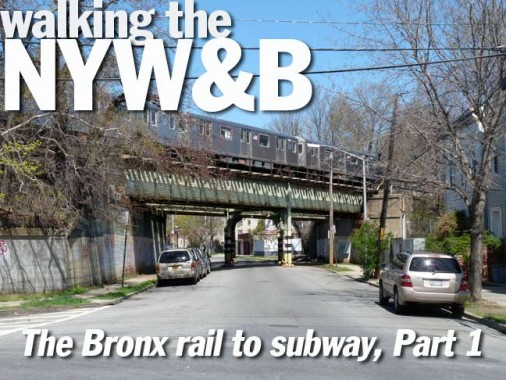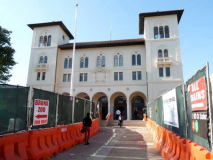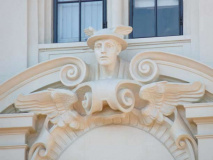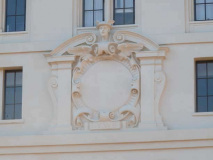There’s a New England undercurrent running through the Bronx. The New York Yankees’ rivalry with the Boston Red Sox began when the Sox’ owner Harry Frazee sold his pitching and slugging star, Babe Ruth, to the Yankees before the 1920 season, and the subsequent championship tally, 27 to 2 in favor of the Yanks, has ratcheted the antagonism toward insanity at times, especially when both teams contend, as has been the case, as of 2012, for over a decade.
But there are other places and landmarks in the Bronx that point toward New England, such as the New England Thruway, the name that Interstate 95 takes between the confluence of the Bruckner Expressway and Hutchinson River Parkway and the Connecticut state line (as named, the New England Thruway actually never touches a New England state; as a New York Jets fan, why does there have to be a road in New York City called “New England”?).
One of the Bronx’ longest roads is Boston Road, which arises at Third Avenue in Morrisania and roars northeast to the city line in Eastchester, with a break for the Bronx Zoo. In northeast Bronx it assumes the mantle of United States Route 1, which runs from Key West, Florida to northern Maine, and if you follow US 1, which is called the Boston Post Road for part of its route, you will indeed catch sight of the Prudential Center and The Hancock Tower after several hours’ driving, though I-95 is much faster.
[see Eric Jaffe’s excellent The King’s Best Highway for the complete Boston Post Road story.]
That brings us to the former New York, Westchester & Boston Railway, which is celebrating its centennial in 2012. When conceived, it was assumed that it would eventually reach Boston, but instead at its lengthiest, it ran from southern Mott Haven in the Bronx to two terminals in Westchester County, at White Plains and at Port Chester. Originally conceived in 1872, it was delayed for a few decades by the Panic of 1873, essentially a depression. Once emerging from receivership in the early 1900s, the railroad began construction in 1906 and built north, with the northernmost stations at Rye and Port Chester opening in 1928 and 1929. When most stations opened in 1912, the NYW&B was considered state of the art for its time, taking power from overhead lines, no grade crossings, high platforms to enable comfortable boarding, and spacious, architecturally attractive ticket offices/station houses.
Despite its advantages, the NYW&B was not a success. When it opened, the automobile industry was beginning to take off — by the 1920s, scenic parkways had appeared to handle intracity auto traffic, and the NYW&B could not reallly compete as a commuter railroad because it ended its run in Mott Haven and riders had to detrain and switch to the Third Avenue El to get to Manhattan. It soldiered on for a decade, but finally declared bankruptcy in 1937, ending service.
But all was not lost. The City of New York saw a golden opportunity to expand service into Pelham Gardens and Eastchester, and purchased the NYW&B right of way, stations, and tracks. After making modifications like adding a third rail, the NYW&B became the Dyre Avenue Shuttle in 1940, and after new tracks were installed to connect it with the White Plains Road el in the 1950s, the full-fledged Dyre Avenue Line, today the home of the #5 train.
In early April 2012 I walked the route, or the closest possible approximation along the tracks, from the Bronx Park East station all the way northeast to Dyre Avenue. It gave me a chance to traverse the Pelham Gardens and Eastchester sections of the Bronx, which I’m in just a few times per year, and to approach both the subway route and the neighborhoods it travels through with a fresh perspective.
TOUR ROUTE
East 180th Street
I didn’t start at the East 180th Street station at Morris Park Avenue, but I can’t help but cite the station house, which is the largest in the New York City subway system. It was recently renovated and painted, and houses the station entrance turnstiles as well as some offices. It was formerly a police precinct house.
The elevated platforms of the old NYW&B are still standing here. Until a track connection was made in the 1950s, a paper transfer was used to cross from the White Plains Line to these tracks.
The station house bears the image of the NYW&B’s standard-bearer, the Roman messenger god Mercury, with his winged cap and symbol of a staff entwined with two snakes (for more of these examples, see below).
The New York, Westchester & Boston at its furthest extent in the 1930s, from Mott Haven in the south Bronx to mid-Westchester County with branches to White Plains and Port Chester. South of the 180th Street station, the NYW&B shared track with the old New York, New Haven and Hartford Railroad, of which there are still several stations surviving, in incredibly deteriorated states.
By 1940, all that remained of active service on the NYW&B was the shuttle line that ran from 180th Street to Dyre Avenue. I set out to walk this branch in April 2012.
Bronx Park East
As you might expect Bronx Park East is the road bordering the east side of Bronx Park, but it has some quirks that make it interesting. For example, for one block between Birchall Avenue and Unionport Road it does not border Bronx Park at all. It also has something of a personality problem, because just south of Pelham Parkway it becomes Boston Road, only to resume its identity north of the Parkway. Whereupon it loses it again at Burke Avenue, where it become Bronx Boulevard.
I got off the #2 train at Bronx Park East to embark on my NYW&B adventure.
In this view from the platform, the elevated NYW&B curves off to the northeast.
The Bronx Park East station, on the White Plains el, currently hosts the #2 train, which also runs through Crotona Park, Longwood, East Harlem, the Upper West Side, and runs all the way south to “The Junction” at Flatbush and Nostrand. So, it can be said it runs to both The Hub and The Junction.
Bronx Park East opened in 1917 and received an overhaul in 2006, when colored glass artwork, Candida Alvarez’ “B is For Birds in the Bronx” was installed along with new windscreens.
Every time I’m on a FNY mission, I learn something new. Having never gotten off at Bronx Park East before, I was unaware that the el runs over Birchall Avenue (for about 3 blocks). I thought I knew all the streets in NYC that were shadowed by els. I was also unaware that Bronx Park East got the full concrete cladding with terra cotta accents that the els seems to reserve for the more important stations.
I was also pleased to see a pair of now-rare Dwarf double-mast light poles guarding the corners.
I doubt all but the most seasoned Boogiedown Bronxites could tell you where the corner of Birchall and Sagamore is.
White Plains Road spends half its length underneath an el, as it assumes the #2 train from Birchall Avenue just north of Bronx Park East. You can see it in the distance in the second photo. Before its shadowing, White Plains Road gets a foretaste of life in the shadows as the NYW&B tracks are bridged over it at Sagamore Street.
White Plains Road was laid out in 1863. While the name of the road ends at the Bronx-Mount Vernon line, it leads to a route that will get you to the northern Westchester County city of about 56,000.
On July 9, 1776, a copy of the Declaration of Independence was delivered to the New York Provincial Congress, which was meeting in the county courthouse. The delegates quickly adopted a resolution approving the Declaration, thus declaring both the colony’s independence and the formation of the State of New York. The Declaration itself was first publicly read from the steps of the courthouse on July 11. wikipedia
A #5 train runs the Dyre Avenue Line, the successor of the NYW&B, as it is bridged over Cruger Avenue. However, there is something interesting about this particular railroad bridge.
Like the eastern end of the M train, the Brooklyn Broadway-Myrtle Avenue line, the Dyre Avenue Line has its own right-of-way that did not run over a particular street or avenue, although, as we’ll see, parallel avenues and streets were later constructed along its length.
I am still a little remiss about when the northern Bronx street layout was conceived or built. In some cases such as the 1811 Commissioners’ Plan for Manhattan Island, the grid is fairly well-documented, but in other parts of town, not so much. You’re left to wonder if, between 1906 and 1912, when the NYW&B was constructed, did Cruger Avenue exist then, and if so, why place pillars in the center of the street? Unsuspecting neighborhood visitors have probably had a crackup or two on these things.
A number of old relics can be spotted on Cruger between Sagamore Street and Bronxdale Avenue, including this metal “SLOW” sign.
The pillars on the NYW&B don’t have the typical flashing warning lights that el pillars usually have in heavily trafficked areas. These structures I found on the pillar may have once been warning lamps, but they haven’t worked in years.
Cruger Avenue between Sagamore Street and Bronxdale Avenue is also known as Regis Philbin Avenue after the TV personality (1931- ) who was born at 1990 Cruger. When I did a page about the avenue in 2000, there were a couple of blue and white “Regis Philbin Avenue” signs on the poles, but these seem to be desired by memento seeks and are no longer there. A newer sign hangs at Cruger and Bronxdale, rather high on the post (above photo).
Though 1990 Cruger was razed in 2010, an adjoining house pretty much resembles it (below).
In the colonial era, Bear Swamp was situated between what is now Wallace, Fowler, Bronxdale and Lydig Avenues; Bronxdale Avenue carried the name Bear Swamp Road until the early 1900s. I wish the more colorful name had been kept around, so I made a faux blue and white Bronx street sign with it.
1905 Bromley map showing Bear Swamp Road (Bronxdale Avenue) near White Plains Road. The pair of dotted lines on the right mark the proposed route of the New York, Westchester and Boston RR, today’s Dyre Avenue Line.
The full map, which is fascinating, showing the wide open spaces in the northern Bronx of a century ago.
One of the Bronx River’s vanished freshwater wetlands was the Bear Swamp. Draining into the Bronx River about where the Bronx Zoo’s Boston Road entrance is today, it covered over 180 acres east of White Plains Road in the present-day Bronxdale and Van Nest neighborhoods. Bronxdale Avenue follows the line of the old Bear Swamp Road that ran through this marshy area. There may have been a Native American settlement there at one time: in the early 1800s a basin for grinding corn was found cut into a rock outcrop…The original Siwanoy name for the place appears to have been forgotten, but the early colonists called it “Bear Swamp” for good reason. The swamp was a productive hunting ground, and among the animals hunted there were Black Bears, whom the Siwanoy trapped by driving them between converging wooden palisades. Bronx River Alliance
2016 Bronxdale Avenue at Antin Place is a 1928 building from the height of Deco, now home to the Bronx Park Medical Pavilion, but the former home of the Bronxdale Swimming Pool. It’s also the approximate geographical centerpoint of The Bronx.
Whenever I’m in the area I can’t help shooting this impressive turreted apartment building on a triangle-shaped plot at Antin Place and Holland Avenue.
The Bronx High School of Visual Arts is located in a former campus building of Mercy College, which is located in Dobbs Ferry but has campuses in The Bronx (now in Morris Park), Manhattan, White Plains and Yorktown.
Founded in 2002, the Bronx High School for Visual Arts offers a rich arts curriculum. Some students have internships at organizations such the Bronx Museum and the Whitney Museum of American Art. The school, which shares a building with a District 75 school for severely disabled students, has a new library and a new computer lab. Inside Schools
Another massive apartment block, this one at Brady and Barnes Avenues.
The NYW&B is bridged over the intersection of Brady and Matthews Avenues. The SE corner boasts an early 1950s-vintage Curved Mast lamp, which were phased out when the cobra necks started appearing about 1960s, though there are several around town. A shorter pole and a curved mast enable these lamps to light areas that more conventional masts can’t.
Mercury and the Caduceus
As stated before, the emblem of the New York, Westchester and Boston RR was the Roman god Mercury and his caduceus, or rod with two entwined snakes. North of 180th Street and south of Pelham Parkway, the NYW&B is generous in allowing traffic to pass, located on a concrete embankment with iron bridges over the cross streets. At most of these intersections you can find 4 caducei in concrete. North of Esplanade, though (see below) the NYW&B travels in an open cut, forcing a number of detours.
NYW&B concrete embankment, Brady and Matthews Avenues
NYW&B railroad bridge over Muliner Avenue. The caduceus is on the embankment on the left.
The back end of the Morris Park station can be seen at Bogart and Colden Avenues. Tantalizingly, the station cannot be accessed from here: there is a very high hill and the station is actually on two levels, the end of an elevated section and the start of a tunnel.
Access to the Morris Park station from the south is via a short road called Woodmansten Place and a walk up a staircase at Paulding Avenue to Esplanade, where Paulding Avenue resumes at the top of the stairs at the station.
“Woodmansten Place” is almost as long as the very short street, which is named for a colonial-era estate owned by Denton Piersall, who also has a neighborhood avenue named for him.
Morris Park
The Morris Park station, at which the Dyre Avenue Line/NYW&B enters a tunnel that runs for about 10 blocks, is the lone remaining Spanish Mission style station that’s still open; other stations to the south in the style at Westchester Avenue and Hunts Point are in ruins. Though NYW&B stations have been described as spacious, the addition of the high turnstiles has made them a bit more cozy or cramped. In the Bronx, Morris Park is the northernmost station still bearing traces of the old caduceus symbol.
Before the Metrocard, fare collection on the Dyre Avenue line was unusual after working hours. At night, clerks working at the booths (who’d now start closing them) would use an allen wrench to close the tops of the turnstiles and tie the slam gates open. Customers who’d come into the station would be directed to enter through the slam gate, walk up to the platform and pay on the train. When the East 180th Street-bound shuttle train would arrive at the station, only one door on the train would open up. The customer entering the train would drop their exact fare into a Johnson Fare Box (the kind used on buses).
Esplanade
Because of a change in grade, the NYW&B was constructed in a tunnel beneath Paulding and Mace Avenues, which also meant the railroad didn’t interfere with Bronx and Pelham Parkway traffic. A new roadway called the Westchester Esplanade was laid out to cover the paved-over tunnel. That was a mouthful, so it was relatively quickly changed to simply Esplanade.
These two photos, from Robert A. Bang’s The New York, Westchester and Boston Railway Companybook, show the construction of the tunnel now covered by Esplanade in the first decade of the 20th Century. Courtesy Robert A. Bang Collection, John Tolley Archive
Esplanade is now a pleasant neighborhood avenue with an attractive center median. Since there are no sidewalk vents there is no hint at all that a subway is running underneath.
There is a modern building at Lurting Avenue that looks as if it’s filled with offices, but it’s actually the Morningside House nursing home.
For some, the name “Haight” brings to mind the Haight-Ashbury neighborhood in San Francisco, the supposed epicenter of the counterculture in 1967. There are actually two streets in NYC called Haight, one in western Flushing and this one, named for 19th Century landowner Stephen Haight.
One of the Bronx’ busiest intersections is where the Bronx and Pelham Parkway and Williamsbridge Road come together. The NYW&B runs in a tunnel underneath this intersection.
I think it’s a mistake, but the Department of Transportation actually stumbled into the original correct spelling of “Williams Bridge” road here. The road begins as a trickle at Cruger and Adee Avenues in Bronxdale but then picks up steam at Boston Road and roars southeast to Tremont Avenue at Westchester Square. It is named for John Williams’ colonial-era bridge over the Bronx river at Gun Hill Road.
The section of Williamsbridge Road at Pelham Parkway was subnamed for Judge Benjamin F. Nolan in 1996:
Benjamin Francis Nolan (1917-1996) was born in Manhattan on June 22, 1917, the son of Irish immigrants. Raised in Yorkville and a graduate of Regis High School, Judge Nolan attended law school at night and was awarded the Law Review Gold Key in 1950 by St. John’s Law School.
He served with honor during World War II, and was awarded the Army Commendation Medal. After the war Judge Nolan served as commander of the Van Nest Post of the American Legion. He was also founder and president of the Van Nest Little League and president of the Van Nest Civic Association.
Judge Nolan was appointed to the Civil Court by Mayor John Lindsay in December, 1971 and was elected to a full 10-year term in 1972. He was re-elected in 1982, but due to an age restriction was forced to retire in December 1987 at the age of 70. Judge Nolan continued in public service after being appointed a member of the City Council Redistricting Commission. He later served as a Judicial Hearing Officer until his death on April 18, 1996, at the age of 78. NYC.gov
Along Williamsbridge Road and Morris Park Avenue the Department of Transportation has fashioned unusual telephone pole lamps, featuring double masted, bracketed poles with Mission Bell luminaires.
There are a number of ancient yet surviving signs at this intersection, like this neighborhood patrol reminder. I wonder if there is still a Morris Park Patrol.
Kiwanis Club signs (not installed by the DOT) appear with some frequency around town. Kiwanis is a volunteer service club established in 1915 and headquartered in Indianapolis, IN. Its name is derived from an Otchipew Indian expression roughly meaning “we share our talents” or “we build.”
I’m not sure the Williamsbridge Inn is still around.
The Bronx and Pelham Parkway runs from Bronx Park, where it becomes East Fordham Road, to the Bruckner Expressway, where it becomes Shore Road in Pelham Bay Park and connects to the Hutchinson River Parkway.
The Bronx and Pelham Parkway (its official name) was constructed in the early 20th Century in the tradition of “garden trafficways” like Ocean Parkway and Eastern Parkway in Brooklyn, between Bronx and Pelham Bay Parks and bears close resemblance to Mosholu Parkway, i.e. a four-lane main road with access roadways flanking it. Unlike Mosholu, though, Pelham Parkway originally ran through open country; parcels for it were obtained from local landowners.
Rudy Macina Peace Memorial Plaza
The unusual Peace Memorial Plaza/Rudy Macina Square gathers 5 memorials resembling tombstones, memorializing war dead in the Gulf War, Vietnam War, Korean War and World Wars I and II.
A Bronx native from Morris Park, [Rudy] Macina earned the Distinguished Flying Cross and the Air Medal during [World War II]. He returned to Morris Park and gave the neighborhood an aura of espirit de corps.
“I was a sergeant on [Inspector-Instructor] duty in 1976,” said [Morris Park Columbus Day Parade Executive Director Dexter Hendon], who served in the Corps for eight years. “Rudy got a retired Colonel to come in and paint a mural on the side of his building.” Hendon said Macina paid for the painting with his own money. “He just loved the Marine Corps that much.”
The mural that the colonel painted almost 30 years ago depicted the raising of the American flag on Mt. Suribachi, Iwo Jima in 1945. The building and the painting are both still intact on Williamsbridge Road, across the street from the parade’s reviewing stand.
Macina died at the age of 70 in 1993. The intersection of Williamsburg Road and Esplanade, which is a couple blocks down the same road as Macina’s decorated building, was renamed “Rudy Macina Peace Memorial Plaza” in 1999. Today, fellow former Marine Hendon continues to run the Columbus Day parade with similar Marine Corps motivation. Hendon’s sons have also continued the Marine Corps tradition as well. His son Joseph served four years, and his younger son Andrew is scheduled to graduate from recruit training at Marine Corps Recruit Depot Parris Island, S.C., in December. US Marine Corps Reserve
Pelham Parkway Station
Beginning with the Pelham Parkway station at Alfred E. Santangelo Plaza, former NYW&B stations are more low-key and no-frills, with simple concrete buildings. There’s evidence of a former side entrance here, long since paved over. Santangelo was a U.S. Representative in Congress from 1957-1963.
Esplanade holds on to its center mall at the subway stop, but at Astor Avenue, it becomes just another avenue for two blocks. William Astor, a distant relative of fur magnate John Jacob, owned property before the city acquired it and laid out streets.
Morris Park, like the Arthur Avenue section of Norwood to the west, has long been an Italian-American Bronx stronghold. Officially, here we’re in Pelham Gardens, but close enough.
“Another Little Italy, With Scant Parking to Match” [NY Times]
When you see near-identical houses close together like this, they were usually part of a long-ago real estate development, private more often than not. Today anyone can buy one.
I had previously completely overlooked the rhyming corner of Waring and Hering. The latter is named for an early landowner with a notable name: Hercules Hering.
The NYW&B tunnel ends at Mace Avenue, and so does Esplanade. I had hoped to get a closer photo of the open cut the line emerges into, but I didn’t want to damage the lettuce, or whatever crop is growing here.
At Allerton Avenue, one of the major east-west streets in Pelham Gardens along with Gun Hill Road, the NYW&B enters a valley again and is bridged over. Although everything else has changed these railroad bridges look nearly exactly the same as they did in 1906, when they were built.
North of Allerton, Stedman and DeWitt Places parallel the NYW&B against the street grid. DeWitt Place, shown here, has to dodge around the el pillars in order to intersect with Wilson Avenue.
Part 2: the NYW&B from Gun Hill Road to Dyre Avenue
4/17/12



